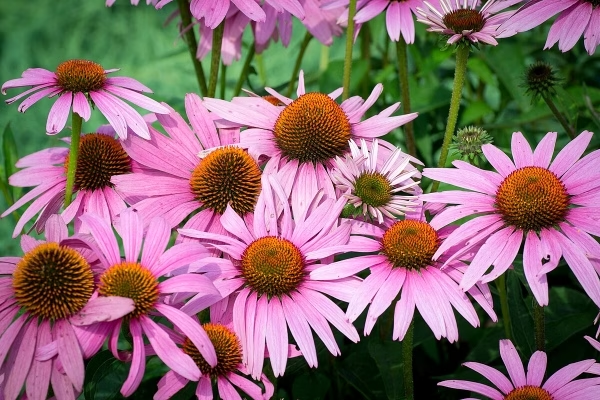
Purple Coneflower
Botanical Name
:
Echinacea purpurea
Plant Type
:
Perennial herb
Seasons
:
Plant in spring; blooms from mid-summer to fall
Sun Level
:
Full sun to partial shade; at least 4 hours of sunlight daily
Ideal Soil Temperature for Planting
:
60–75°F (15–24°C)
Soil Type
:
Well-drained, average soil
Hardiness Zones
:
3–9 (USDA)
Germination
:
10–20 days
P.H. Level
:
6.0–7.5 (slightly acidic to neutral)
Water/Irrigation
:
Water regularly, especially during dry periods. Once established, they are somewhat drought-tolerant
Fertilization
:
Not typically needed, but a light application of balanced fertilizer in spring can be beneficial. Over-fertilizing can lead to excessive foliage and fewer flowers
Habit
:
Upright, branching
Propagation
:
Seed, division (of established clumps in spring or fall)
Final Plant Height
:
2–5 ft
Spread
:
1–2 ft
Flowers
:
Large, daisy-like, with pinkish-purple petals and a dark orange or brown central cone
Attracts
:
Butterflies, bees, and other pollinators
Uses
:
Ornamental (garden beds, borders, cut flowers), medicinal (historically used by Native Americans, now used as a supplement for immune support)
Companions
:
Coneflowers (other Echinacea species), Yarrow (Achillea), Salvia, ornamental grasses
Pruning
:
Deadheading (removing spent flowers) encourages more blooms. Cut back stems in late fall or early spring
Toxicity
:
Generally considered non-toxic to humans and animals, though it’s always best to prevent pets from consuming large quantities of any plant
Pests
:
Aphids, slugs, snails, Japanese beetles
Diseases
:
Powdery mildew, leaf spots, and rust
Confused With
:
Other Echinacea species, sometimes with similar-looking daisies like coreopsis
Additional Info
:
Native to North America. The name “Echinacea” comes from the Greek word for “hedgehog,” referring to the spiny center of the flower
Botanical Name
:
Echinacea purpurea
Plant Type
:
Perennial herb
Seasons
:
Plant in spring; blooms from mid-summer to fall
Sun Level
:
Full sun to partial shade; at least 4 hours of sunlight daily
Ideal Soil Temperature for Planting
:
60–75°F (15–24°C)
Soil Type
:
Well-drained, average soil
Hardiness Zones
:
3–9 (USDA)
Germination
:
10–20 days
P.H. Level
:
6.0–7.5 (slightly acidic to neutral)
Water/Irrigation
:
Water regularly, especially during dry periods. Once established, they are somewhat drought-tolerant
Fertilization
:
Not typically needed, but a light application of balanced fertilizer in spring can be beneficial. Over-fertilizing can lead to excessive foliage and fewer flowers
Habit
:
Upright, branching
Propagation
:
Seed, division (of established clumps in spring or fall)
Final Plant Height
:
2–5 ft
Spread
:
1–2 ft
Flowers
:
Large, daisy-like, with pinkish-purple petals and a dark orange or brown central cone
Attracts
:
Butterflies, bees, and other pollinators
Uses
:
Ornamental (garden beds, borders, cut flowers), medicinal (historically used by Native Americans, now used as a supplement for immune support)
Companions
:
Coneflowers (other Echinacea species), Yarrow (Achillea), Salvia, ornamental grasses
Pruning
:
Deadheading (removing spent flowers) encourages more blooms. Cut back stems in late fall or early spring
Toxicity
:
Generally considered non-toxic to humans and animals, though it’s always best to prevent pets from consuming large quantities of any plant
Pests
:
Aphids, slugs, snails, Japanese beetles
Diseases
:
Powdery mildew, leaf spots, and rust
Confused With
:
Other Echinacea species, sometimes with similar-looking daisies like coreopsis
Additional Info
:
Native to North America. The name “Echinacea” comes from the Greek word for “hedgehog,” referring to the spiny center of the flower
Written by Nondiah Khalayi – https://www.linkedin.com/in/nondiah-khalayi/

